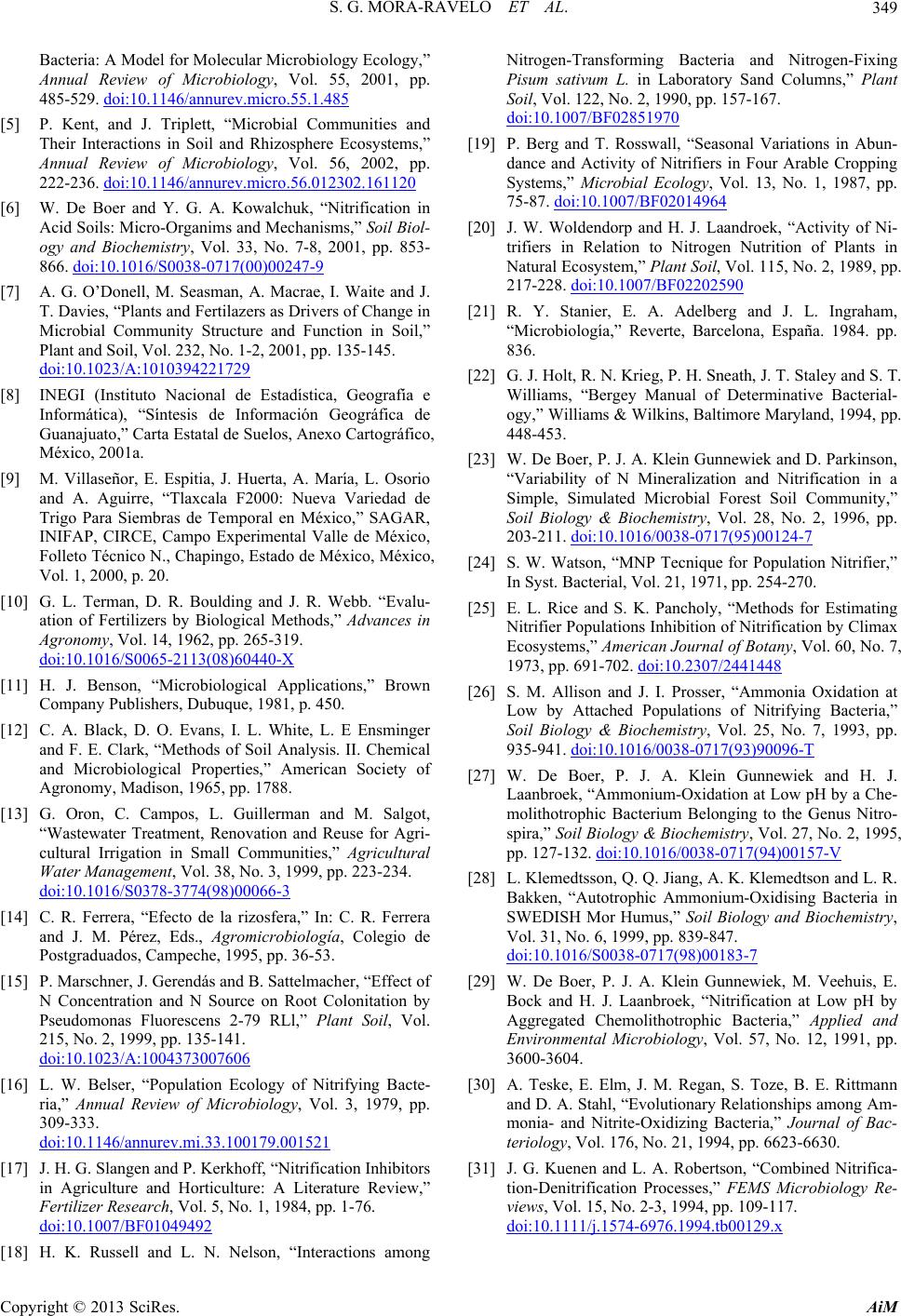
S. G. MORA-RAVELO ET AL.
Copyright © 2013 SciRes. AiM
349
Bacteria: A Model for Molecular Microbiology Ecology,”
Annual Review of Microbiology, Vol. 55, 2001, pp.
485-529. doi:10.1146/annurev.micro.55.1.485
[5] P. Kent, and J. Triplett, “Microbial Communities and
Their Interactions in Soil and Rhizosphere Ecosystems,”
Annual Review of Microbiology, Vol. 56, 2002, pp.
222-236. doi:10.1146/annurev.micro.56.012302.161120
[6] W. De Boer and Y. G. A. Kowalchuk, “Nitrification in
Acid Soils: Micro-Organims and Mechanisms,” Soil B iol-
ogy and Biochemistry, Vol. 33, No. 7-8, 2001, pp. 853-
866. doi:10.1016/S0038-0717(00)00247-9
[7] A. G. O’Donell, M. Seasman, A. Macrae, I. Waite and J.
T. Davies, “Plants and Fertilazers as Drivers of Change in
Microbial Community Structure and Function in Soil,”
Plant and Soil, Vol. 232, No. 1-2, 2001, pp. 135-145.
doi:10.1023/A:1010394221729
[8] INEGI (Instituto Nacional de Estadística, Geografía e
Informática), “Síntesis de Información Geográfica de
Guanajuato,” Carta Estatal de Suelos, Anexo Cartográfico,
México, 2001a.
[9] M. Villaseñor, E. Espitia, J. Huerta, A. María, L. Osorio
and A. Aguirre, “Tlaxcala F2000: Nueva Variedad de
Trigo Para Siembras de Temporal en México,” SAGAR,
INIFAP, CIRCE, Campo Experimental Valle de México,
Folleto Técnico N., Chapingo, Estado de México, México,
Vol. 1, 2000, p. 20.
[10] G. L. Terman, D. R. Boulding and J. R. Webb. “Evalu-
ation of Fertilizers by Biological Methods,” Advances in
Agronomy, Vol. 14, 1962, pp. 265-319.
doi:10.1016/S0065-2113(08)60440-X
[11] H. J. Benson, “Microbiological Applications,” Brown
Company Publishers, Dubuque, 1981, p. 450.
[12] C. A. Black, D. O. Evans, I. L. White, L. E Ensminger
and F. E. Clark, “Methods of Soil Analysis. II. Chemical
and Microbiological Properties,” American Society of
Agronomy, Madison, 1965, pp. 1788.
[13] G. Oron, C. Campos, L. Guillerman and M. Salgot,
“Wastewater Treatment, Renovation and Reuse for Agri-
cultural Irrigation in Small Communities,” Agricultural
Water Management, Vol. 38, No. 3, 1999, pp. 223-234.
doi:10.1016/S0378-3774(98)00066-3
[14] C. R. Ferrera, “Efecto de la rizosfera,” In: C. R. Ferrera
and J. M. Pérez, Eds., Agromicrobiología, Colegio de
Postgraduados, Campeche, 1995, pp. 36-53.
[15] P. Marschner, J. Gerendás and B. Sattelmacher, “Effect of
N Concentration and N Source on Root Colonitation by
Pseudomonas Fluorescens 2-79 RLl,” Plant Soil, Vol.
215, No. 2, 1999, pp. 135-141.
doi:10.1023/A:1004373007606
[16] L. W. Belser, “Population Ecology of Nitrifying Bacte-
ria,” Annual Review of Microbiology, Vol. 3, 1979, pp.
309-333.
doi:10.1146/annurev.mi.33.100179.001521
[17] J. H. G. Slangen and P. Kerkhoff, “Nitrification Inhibitors
in Agriculture and Horticulture: A Literature Review,”
Fertilizer Research, Vol. 5, No. 1, 1984, pp. 1-76.
doi:10.1007/BF01049492
[18] H. K. Russell and L. N. Nelson, “Interactions among
Nitrogen-Transforming Bacteria and Nitrogen-Fixing
Pisum sativum L. in Laboratory Sand Columns,” Plant
Soil, Vol. 122, No. 2, 1990, pp. 157-167.
doi:10.1007/BF02851970
[19] P. Berg and T. Rosswall, “Seasonal Variations in Abun-
dance and Activity of Nitrifiers in Four Arable Cropping
Systems,” Microbial Ecology, Vol. 13, No. 1, 1987, pp.
75-87. doi:10.1007/BF02014964
[20] J. W. Woldendorp and H. J. Laandroek, “Activity of Ni-
trifiers in Relation to Nitrogen Nutrition of Plants in
Natural Ecosystem,” Plant Soil, Vol. 115, No. 2, 1989, pp.
217-228. doi:10.1007/BF02202590
[21] R. Y. Stanier, E. A. Adelberg and J. L. Ingraham,
“Microbiología,” Reverte, Barcelona, España. 1984. pp.
836.
[22] G. J. Holt, R. N. Krieg, P. H. Sneath, J. T. Staley and S. T.
Williams, “Bergey Manual of Determinative Bacterial-
ogy,” Williams & Wilkins, Baltimore Maryland, 1994, pp.
448-453.
[23] W. De Boer, P. J. A. Klein Gunnewiek and D. Parkinson,
“Variability of N Mineralization and Nitrification in a
Simple, Simulated Microbial Forest Soil Community,”
Soil Biology & Biochemistry, Vol. 28, No. 2, 1996, pp.
203-211. doi:10.1016/0038-0717(95)00124-7
[24] S. W. Watson, “MNP Tecnique for Population Nitrifier,”
In Syst. Bacterial, Vol. 21, 1971, pp. 254-270.
[25] E. L. Rice and S. K. Pancholy, “Methods for Estimating
Nitrifier Populations Inhibition of Nitrification by Climax
Ecosystems,” American Journal of Botany, Vol. 60, No. 7,
1973, pp. 691-702. doi:10.2307/2441448
[26] S. M. Allison and J. I. Prosser, “Ammonia Oxidation at
Low by Attached Populations of Nitrifying Bacteria,”
Soil Biology & Biochemistry, Vol. 25, No. 7, 1993, pp.
935-941. doi:10.1016/0038-0717(93)90096-T
[27] W. De Boer, P. J. A. Klein Gunnewiek and H. J.
Laanbroek, “Ammonium-Oxidation at Low pH by a Che-
molithotrophic Bacterium Belonging to the Genus Nitro-
spira,” Soil Biology & Biochemistry, Vol. 27, No. 2, 1995,
pp. 127-132. doi:10.1016/0038-0717(94)00157-V
[28] L. Klemedtsson, Q. Q. Jiang, A. K. Klemedtson and L. R.
Bakken, “Autotrophic Ammonium-Oxidising Bacteria in
SWEDISH Mor Humus,” Soil Biology and Biochemistry,
Vol. 31, No. 6, 1999, pp. 839-847.
doi:10.1016/S0038-0717(98)00183-7
[29] W. De Boer, P. J. A. Klein Gunnewiek, M. Veehuis, E.
Bock and H. J. Laanbroek, “Nitrification at Low pH by
Aggregated Chemolithotrophic Bacteria,” Applied and
Environmental Microbiology, Vol. 57, No. 12, 1991, pp.
3600-3604.
[30] A. Teske, E. Elm, J. M. Regan, S. Toze, B. E. Rittmann
and D. A. Stahl, “Evolutionary Relationships among Am-
monia- and Nitrite-Oxidizing Bacteria,” Journal of Bac-
teriology, Vol. 176, No. 21, 1994, pp. 6623-6630.
[31] J. G. Kuenen and L. A. Robertson, “Combined Nitrifica-
tion-Denitrification Processes,” FEMS Microbiology Re-
views, Vol. 15, No. 2-3, 1994, pp. 109-117.
doi:10.1111/j.1574-6976.1994.tb00129.x